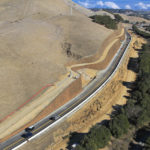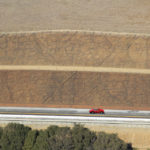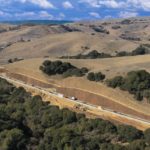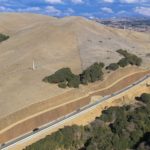- Company: Ghilotti Construction Company
- Industry: General Building
- Location: Santa Rosa, California
- Expected Completion Date: August 14, 2014
- Project Website
The goal of the Highway 12 Jameson Canyon Road Project was to widen two sections of Highway 12, a heavily traveled road connecting the Highway 80 corridor to Napa and the northern counties of California.
The road was open throughout all phases of construction, which made the project all the more challenging. Bringing in materials and hauling them off, as well as mobilizing operations, was difficult due to the road being open. To work around this issue, all major haul-off operations took place at night , when traffic was heavily reduced.
Because this section of Highway 12 passes through a canyon/ ravine area, three large soil nail retaining walls had to be built. Each wall was over 2,000ft long and altogether totaled 120 ft in height. With the highway open throughout construction, a rock/debris catch fence capable of stopping car-sized boulders had to be designed and installed before the wall installation could get under way.
“What was unique about the project is that not only did it involve extensive excavations and extremely tall soil nail retaining walls, but they also needed to be aesthetically pleasing, including sculpted concrete and staining to mimic the surrounding landscape.” Jared Herrington, project manager for Ghilotti Construction Company.
Coordination of many moving parts was an important part of making this project a success. The Solano and Napa county sections of the project were managed by two different project teams and had to be in sync as much as possible. In addition, as part of this project, almost 5,000 ft of 36-in. welded steel pipe waterline was replaced for the city of Vallejo, adding an extra level of coordination.
Landowner and homeowner communication also was an important component of this project, because residents up and down Highway 12 dealt with many access modifications to their driveways, etc., and all parties wanted to keep impacts to a minimum.
What impact does this project have on America?
Hwy 12/Jameson Canyon is a major thoroughfare for people heading up to the Napa/Sonoma wine country, and prior to this project it was a narrow winding 2-lane conventional highway that was very dangerous and had numerous traffic accidents. This project not only will help prevent accidents and injuries, but will make one of the prettiest most scenic drives even more breathtaking.
What interesting obstacles or unusual circumstances did you overcome to complete the project?
· The largest overall challenge on the project was the construction of three large soil nail retaining walls through the canyon/ravine area of Hwy 12. These walls were each over 2000’ in length, and all together totaled over 120’ in height. With this type of wall, construction begins at the top and the existing hillside is excavated and off-hauled 5’ at a time, until over 300,000 cubic yards of dirt is removed. The challenge with this wall is that the existing Hwy 12 remained open at the bottom of the hill during construction. In order to keep the Hwy open, a rock/debris catch fence, capable of stopping car-sized boulders, had to be designed and installed prior to any construction began. Just installing the fence was a challenge given the near vertical conditions of the existing hillside with traffic directly beneath installation activities. In the end, the fence was installed and the hillside was removed safely and efficiently with no incidents.
· Due to varying conditions, a large amount of design changes were implemented throughout the construction of the project. Both teams, contractor and owner (Caltrans), worked together extremely efficiently in order to minimize work stoppage throughout these design modifications.
· Hwy 12 is an extremely high-traveled road connecting the Hwy 80 corridor to Napa and the northern counties. With the road being open throughout all phases of construction, this created many challenges in terms of mobilizing operations throughout the job, as well has bringing materials in and off-hauling materials out. In order to minimize impacts to the traveling public, all major off-haul operations were conducted at night when traffic is heavily reduced.
· The project is located within a number of environmentally sensitive areas which created additional challenges. For the vast majority of the construction, the project maintained an excellent standing in terms of both biological and environmental rating with no major impacts resulting.
· With both the Solano and Napa county portions of the Hwy 12 widening taking place simultaneously, this presented many challenges as many activities had to be coordinated between the two adjacent projects. Multiple meetings were held between both project teams and the overall impacts to both projects was very minimal despite the close proximity and limited access.
· Landowner/homeowner communication was also a challenge as the people living up and down Hwy 12 were faced with many access modifications to their driveways, etc. Communication was held open throughout the project and despite the complexity, impacts were held to a very minimum.
· A portion of the project included the replacing of almost 5000’ of 36” welded steel pipe waterline for the City of Vallejo. Throughout the construction of the line, multiple design changes were required which could have greatly impacted the overall durations of the overall project. Although delays were encountered, these were held to a minimum given the open communication lines maintained with the owners.
What dangers and risks did you encounter, and describe any extraordinary methods used to keep workers safe?
Traffic was flowing through the area over 100’ below on the existing Hwy 12, and needed to be protected from any possible falling rocks, etc. In order to do this, over 1200’ of an engineered anchored rock fall fence was installed towards the bottom of the slope. We’re happy to say there were no impacts or accidents involving the existing Hwy traffic.
How did you leverage new technologies to work faster and reduce waste?
GCC is highly innovated in its approach to business. The company believes that two-way communication is key to efficient, cost-effective operations. Ghilotti has made a rapid transition over the years from push-to-talk radios and pagers to smartphones, from typewriters to computers, laptops and iPads, as well as from paper to electronic reporting, lasers and GPS systems. New ideas and methods are researched and incorporated, along with the most advanced equipment.





